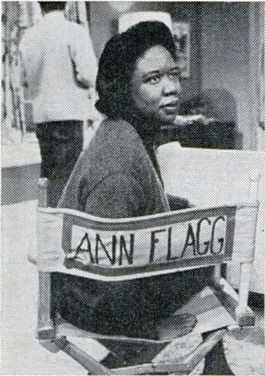Ann Flagg facts for kids
Quick facts for kids
Ann Flagg
|
|
|---|---|

Ann Flagg on the set of Great Gettin' up Mornin'
|
|
| Born | April 29, 1924 Charleston |
| Died | October 27, 1970 Illinois |
Ann Kathryn Flagg (born April 29, 1924 – died October 27, 1970) was an American writer, actress, and drama teacher. She wrote plays about the experiences of African Americans in the 1800s and 1900s. Ann Flagg is most famous for her play Great Gettin' up Mornin'. This play was shown on CBS television in 1964.
Contents
Ann Flagg's Early Life and Education
Ann Flagg was born on April 29, 1924. Her hometown was Charleston, West Virginia. Her parents were Frances Thomas and Francis Flagg. They separated when Ann was a child.
In 1941, she finished high school at Garnet High School. She was very good at drama there. She also took part in the summer theater program at West Virginia State College.
She then went to West Virginia State College. She graduated in 1945 with a degree in education. She earned high honors, meaning she was a top student. At college, she joined the West Virginia State Players. She was even their president for a semester. She acted in plays like The Shining Hour.
Ann Flagg's Teaching and Theater Career
After college, Ann Flagg taught for two years. She taught at Northampton County High School in Machipongo, Virginia. She helped her students win second place in a theater tournament.
Then, she toured for a year with the American Negro Repertory Players. This was a group of actors. She later returned to teaching at Dunbar High School. She taught drama, English, and Spanish. She also took speech classes at the University of Pittsburgh. This helped her teach speech too.
In 1952, she became the director of the Children's Theater. This was at Karamu House in Cleveland, Ohio. Karamu House was a special theater. It brought together people of all races. For nine years, she directed many plays and ballets with children. Her classroom was called "The Magic Carpet Room". People said it "lifted minds and hearts to mountain tops."
Ann Flagg also acted in plays for adults. She performed in Antigone and Lysistrata. Her acting was highly praised.
Her Famous Play and Later Years
From 1961 to 1963, she studied for her master's degree. This was in theater at Northwestern University. While there, she finished her most famous play. It was called Great Gettin' up Mornin'.
In 1963, her play won first prize. It was in the Samuel French annual college playwriting contest. This award helped her play get noticed. The TV show CBS Repertoire Workshop decided to produce it. The play aired on TV in 1964. Famous actors like Nichelle Nichols starred in it. Ann Flagg went to Hollywood to help with the TV production.
While at Northwestern, she started teaching drama part-time. She taught in the Evanston Consolidated School District. After graduating, she became a full-time teacher. She taught at the Foster School. This school later became the King Lab. The school's auditorium is now named after her.
In 1966, she taught drama for a year. This was at Southern Illinois University Carbondale. However, she had health problems. She returned to Evanston the next year. Ann Flagg passed away suddenly in 1970. She was 46 years old.
Ann Flagg's Works
Ann Flagg wrote several important plays. Her plays often explored the lives of African Americans.
- Great Gettin' up Mornin' (1963)
- This is her most famous play. It is about a couple. They must decide if they will send their daughter to a newly integrated school. An integrated school is one where students of all races attend together. The family faces threats because of this decision.
- Ann Flagg wrote this play to be short and powerful. She wanted to show a family making a huge choice under stress. The play's title comes from a type of religious song called a spiritual.
- Blueboy to Holiday - Over -
- This play shows the friendship between two eight-year-old boys. One boy is white, and the other is black.
- A Significant Statistic -
- This work tells the story of a fictional civil rights worker named Jack Davis. Civil rights workers fought for equal rights for all people.
- Unto the Least of These -
- Ann Flagg was inspired by a tombstone she saw. It was for a four-year-old fugitive slave. A fugitive slave was someone who escaped slavery.
- This play shows a station on the Underground Railroad in 1853. The Underground Railroad was a secret network. It helped enslaved people escape to freedom.
- The Young Shall Die (unfinished)
- This play was based on a poem by Carl Sandberg. Ann Flagg was still working on it when she died.

